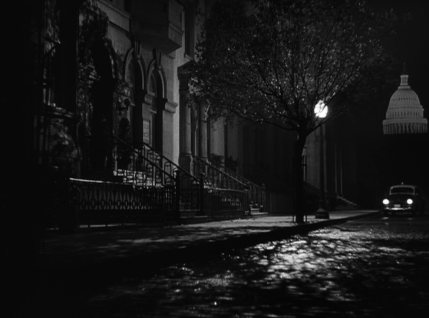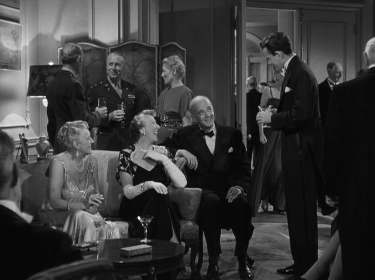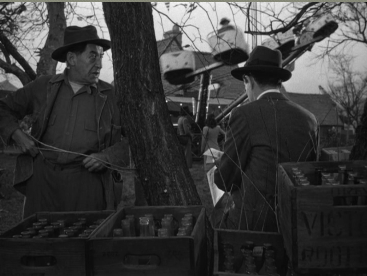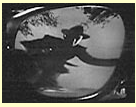Introduction
Alfred Hitchcock’s film ‘Strangers on a Train’ is a captivating masterpiece whose story follows the life of two strangers who meet on a train with a common agenda of murdering someone. On one hand is Guy who is keen on murdering his promiscuous and cruel wife while Bruno is on the other hand planning to eliminate his father (Strangers on a Train).
Following the events that are depicted in the movie in the quest of achieving the goals that each of the two main characters have, the film reveals central themes. One of the most overarching themes is the fate vs. determination. In this theme, the main question is whether many of the events that occur during the movie are because of fate or they are a function of main actors.
The use of German expressionism is also evident throughout the film, as it will be discussed in the paper. As the paper reveals, an accidental incident is witnessed where two strangers bump into one another to produce consequences that neither of them can control.
The Power of Random Events
Firstly, the movie begins with Bruno and Guy meeting on a train for the first time (Strangers on a Train). In their conversation, it is evident that both have sinister plans of murdering someone who is close to them but for selfish reasons. For instance, Guy wants to eliminate his promiscuous wife so that he can marry a beautiful woman, namely Anne, while Bruno wants to kill his father who he accuses of living in luxury with his mother when he (Bruno) is struggling with life (Strangers on a Train).
In this instance, it is difficult to conclude whether it is fate or a well thought out plan by Bruno who already knows Guy’s whereabouts. However, one thing is clear to Guy that fate brings Bruno. On the other hand, it is evident that they both have the determination to achieve their goals.
Determination is a major quality that Guy exhibits throughout the movie. From the beginning, Guy is not comfortable with his way of life. His failed marriage, slow career growth, and other major drawbacks in his life reveal a young man who is no longer contented with who he has become. Hence, he is determined to seek a political seat, which he believes it will offer him a better chance to life (Strangers on a Train).
He is also determined to be with the woman he believes he loves and who will treat him better than his wife Miriam. It is also evident that his interest in Anne is also based on more reasons other than love. Anne comes from a well-connected family.
Hence, she has the potential of linking him to the right people who will help him to advance his career into politics and hence transition from low social class to the higher classes of the society (Strangers on a Train). Guy’s aspiration for political position is evident in the movie. The Capitol Building that appears on the background of his home substantiates this claim.

The lights and shadows that are evident in the above scene are a major characteristic of German expressionism where such lighting and shadows are used to show sharp contrast (Bazin and Gray 5; Gottlieb 37). According to Roberts, incidents of light and darkness are used as an artistic tool that shows where the real and fantasy worlds meet (5). In the movie, they represent the deeper feelings and thoughts of a character.
Another major twist in the movie is the fact that Bruno is mostly used as a reflection of Guy’s deeper intentions, as well as his wrong or evil side. In this case, while the movie shows that Bruno commits the ultimate crime by killing Miriam, it is evident also that Guy had the real intentions of eliminating his wife (Strangers on a Train).
In other words, Bruno is a doppelganger of Guy, a role that he plays perfectly. In this case, Bruno is a reflection of what Guy wants to become. For instance, Bruno is rich, comes from a well-connected family, and above all has the upper social class background as status that Guy wants to achieve. In the movie, the reflection of Bruno’s wealthy life is evident in the scene where his affluent family is attending a dinner in one of Washington’s prosperous political figures as shown below:

The Degree to Which People can Control their Lives
The movie demonstrates an insignificant power of people to control their lives. The level of influence of people is a function of other forces such as the level of poverty or wealth. In the above scene in figure 2, it is clear that the dinner party in the scene has attracted the powerful members of the society. For instance, on the background is a man dressed in army uniform, which represents authority.
Further, a judge and a representative of education and culture are also present in the party as an indication of power (Strangers on a Train). Giannetti’s work addresses the various languages that filmmakers use to pass their artistic messages to their audiences (2). For instance, the black men servants symbolize higher statuses of individuals in the party where servants serve them from the lower segments of the society. Guy wants to join this social class. Hence, he is determined to get it at all cost.
On the contrary, Guy comes from a poor background as evident in the depiction of his hometown, Metcalf, which is a low-class town that lacks affluent people (Strangers on a Train). The following scene depicts the town of Metcalf:

According to Gottlieb, the use of mirrors in the movie to convey important messages and intentions that are also presented through the darkness of the movie and Bruno’s plans is a common feature (37). However, the most central application of mirrors is evident when the images of Bruno straggling Miriam are shown as a reflection on a concave mirror (Strangers on a Train).
The scene uses visual and sound effects to ensure that the viewer feels the desperation of Miriam as she slowly loses her life. On the other hand, the scene depicts the evil nature of Bruno who is a heartless murderer.
However, from the background, Miriam’s friends are searching her, although it seems that fate is not on Miriam’s side, as they never spot her until it is already too late when she is dead. According to Dellolio, the death has its share of conflicting outcomes, including the relief to Guy that Miriam has passed on and the fact that he will be held accountable for the death (261).

As fate would have it, Guy does not honor his part of the bargain since he fails to go with the plans to kill Bruno’s father. However, Bruno is a deceiving character who intends to implicate Guy by planting Guy’s lighter at the scene of the crime. Luck is not on Bruno’s side since Guy reports the matter and arrives at the scene where the crime was committed. His goal is to wait for Bruno to show up on his way to planting the lighter to implicate Guy.
When Bruno arrives, he is seriously injured. However, while it may be too late to save his life, as he lies down, his hands unfold to the extent of revealing Guy’s lighter and hence a proof that he was the murderer who was in a mission to implicate an innocent person (Strangers on a Train). Concisely, Guy gets his wishes firstly by disarming Anne since Miriam is no longer available and secondly by getting a good opportunity to become a politician since he has the necessary connection by virtue of being with Anne.
Conclusion
Based on the above expositions, both self-determination and fate play an essential role in advancing Guy’s interests. While Guy is determined to become a politician, fate plays its role by bringing Bruno who then eliminates Miriam and consequently leaves Guy with the best opportunity for a political position.
Further, the fact that Bruno is no longer capable of implicating Guy on the murder of his wife Miriam confirms how fate has worked in favor of Guy. However, with Anne on his side, he is on the right path to becoming a politician. This state of affairs requires his self-determination in ensuring that he gets the coveted political position.
Works Cited
Bazin, André, and Hugh Gray. “The Ontology of the Photographic Image.” Film Quarterly 13.4(1960): 4-9. Print.
Dellolio, Peter. “Expressionist Themes in Strangers on a Train.” Literature Film Quarterly 31.4(2003): 260-269. Print.
Giannetti, Louis. Understanding Movies, New York, NY: Pearson, 2014. Print.
Gottlieb, Sidney. Early Hitchcock: The German Influence, Detroit, Michigan: Wayne State University Press, 2002. Print.
Roberts, Ian. German Expressionist Cinema: The World of Light and Shadow, New York, NY: Wallflower, 2008. Print.
Strangers on a Train. Ex. Prod. Alfred Hitchcock. Bendigo, Vic.: Video Education Australasia. 2005. DVD.